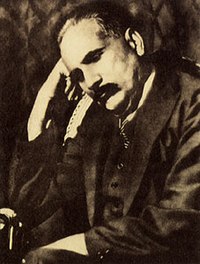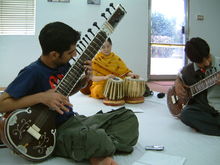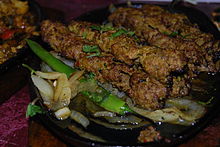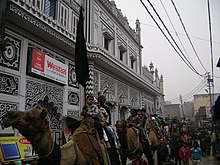The society and culture of Pakistan (Urdu: ثقافتِ پاکستان S̱aqāfat-e Pākistān) comprises numerous ethnic groups: thePunjabis, Kashmiris, Sindhis in east, Muhajirs, Makrani in the south; Baloch and Pashtun in the west; and the ancientDardic, Wakhi, Baltistani and Burusho communities in the north. The culture of these Pakistani ethnic groups have been greatly influenced by many of its neighbors, such as the other South Asians, Turkic peoples as well as the peoples ofCentral Asia and the Middle East.
The origins of the current Pakistani culture can be traced back to the Indus Valley civilization, which was contemporaneous with the ancient Egyptian and Sumerian civilizations, around 5500 years ago. The region has formed a distinct unit within the main geographical complex of South Asia, the Middle East and Central Asia from the earliest times, and is analogous to the position of Afghanistan.[1] There are differences among the ethnic groups in cultural aspects such as dress, food, and religion, especially where pre-Islamic customs differ from Islamic practices. Their cultural origins also reveal influences from far afield, including China, India and Afghanistan. Pakistan was the first region of South Asia to be fully impacted by Islam and has thus developed a distinct Islamic identity, historically different from areas further east.[1]
Contents
[hide]Literature[edit]
Pakistani literature originates from when Pakistan gained its independence as a sovereign state in 1947. The common and shared tradition of Urdu literature and English literature of Greater India was inherited by the new state. Over a period of time, a body of literature unique to Pakistan emerged, written in nearly all major Pakistani languages, including Urdu, English, Punjabi,Pashto, Seraiki, Balochi, and Sindhi.
Poetry[edit]
Main articles: Pakistani poetry and List of Urdu Poets
Poetry is a highly respected art and profession in Pakistan. The pre-eminent form of poetry in Pakistan almost always originates in Persian, due in part to the long-standing affiliation and heavy admiration the regions rulers once had for certain aspects of foreign Persian culture. The enthusiasm for poetry exists at a regional level as well, with nearly all of Pakistan's provincial languages continuing the legacy. Since the independence of the country in 1947 and establishment of Urdu as the national language, poetry is written in that language as well. The Urdu language has a rich tradition of poetry and includes the famous poets Dr. Allama Iqbal (national poet), Meer Taqi Meer, Mirza Ghalib, Faiz Ahmad Faiz, Ahmad Faraz, Habib Jalib, Jazib Qureshi, and Ahmad Nadeem Qasimi. Apart from Urdu poetry, Pakistani poetry also has blends of other regional languages. Balochi, Sindhi, Punjabi, Seraiki, and Pashto poetry have all incorporated and influenced Pakistani poetry. Poetry in the form ofmarsia salam and naath is also very popular among many Pakistanis.
Performing arts[edit]
Music[edit]
Main article: Music of Pakistan
The variety of Pakistani music ranges from diverse provincial folk music and traditional styles such as Qawwali and Ghazal Gayaki to modern forms fusing traditional and Western music, such as the synchronisation of Qawwali and Western music by the world-renowned Nusrat Fateh Ali Khan. In addition Pakistan is home to many famous folk singers such as the lateAlam Lohar, who is also well known in Indian Punjab. The arrival of Afghan refugees in the western provinces has rekindledDari music and established Peshawar as a hub for Afghani musicians and a distribution center for Afghani music abroad.
Dances[edit]
Folk dances are still popular in Pakistan and vary according to region such as:
Punjab[edit]
Main article: Folk dances of Punjab
Balochistan[edit]
- Lewa - Baluch folk dance from Makran region
- Chap - Baluch folk dance performed at weddings
- Jhumar - Saraiki, Punjabi and Balochi folk dance
Khyber Pakhtunkhwa[edit]
- Attan - Folk dance of Pashtuns tribes of Pakistan including the unique styles of Quetta and Waziristan
- Khattak Dance - sword dance of Khattak tribe in Khyber-Pakhtunkhwa
- Gumhar and Gatka - Popular dance of hazara division Khyber-Pakhtunkhwa
- Chitrali Dance - Khyber-Pakhtunkhwa
Sindh[edit]
Drama and theatre[edit]
Main article: Theatre in Pakistan
These are very similar to stage plays in theatres. They are performed by well-known actors and actresses in the Lollywood industry. The dramas and plays often deal with themes from everyday life, often with a humorous touch.
Visual arts[edit]
Painting[edit]
Abdul Rehman Chughtai, Sughra Rababi, Ustad Allah Baksh, Aboo B. Rana, Ajaz Anwar, Ismail Gulgee, Jamil Naqsh, and Sadequain are prominent and outstanding creative painters of Pakistan. Pakistani vehicle art is a popular folk art.
Architecture[edit]
Main article: Pakistani architecture
The architecture of the areas now constituting Pakistan can be traced to four distinct periods: pre-Islamic, Islamic, colonial, and post-colonial. With the beginning of the Indus civilization around the middle of the 3rd millennium[2] B.C., an advancedurban culture developed for the first time in the region, with large structural facilities, some of which survive to this day.[3]Mohenjo Daro, Harappa and Kot Diji belong to the pre-Islamic era settlements. The rise of Buddhism, Guptas, Mouryas, and the Persian and Greek influence led to the development of the Greco-Buddhist style, starting from the 1st century CE. The high point of this era was reached with the culmination of the Gandhara style. An example of Buddhist architecture is the ruins of the Buddhist monastery Takht-i-Bahi in Khyber-Pakhtunkhwa.
The arrival of Islam in today's Pakistan introduced the classical Islamic construction techniques into Pakistan's architectural landscape.[4] However, a smooth transition to predominantly picture-less Islamic architecture occurred. The town of Uch Sharif contains the tombs of Bibi Jawindi, Baha'al-Halim, and Jalaluddin Bukhari, which are considered some of the earliest examples of Islamic architecture in Pakistan and are on the UNESCO Tentative World Heritage Site list since 2004.[5] One of the most important of the few examples of the Persian style of architecture is the tomb of the Shah Rukn-i-Alam in Multan. During the Mughal era, design elements of Islamic-Persian architecture were fused with, and often produced playful forms of, local art, resulting in the establishment of Mughal Architecture. Lahore, occasional residence of Mughal rulers, exhibits a multiplicity of important buildings from the empire, among them the Badshahi mosque, the fortress of Lahore with the famous Alamgiri Gate, the colourful, still strongly Mughal-influenced Wazir Khan Mosque as well as numerous other mosques and mausoleums. The Shahjahan Mosque of Thatta in Sindh also originates from the epoch of the Mughals, as does the Mohabbat Khan Mosque in Peshawar.
In the British colonial age, the buildings developed were predominantly of the Indo-European style, with a mixture of European and Indian-Islamic components. Post-colonial national identity is expressed in modern structures like the Faisal Mosque, the Minar-e-Pakistan and theMazar-e-Quaid.
Recreation and sports[edit]
Main article: Sports in Pakistan
The official national sport of Pakistan is field hockey, but cricket and squash are the most popular sports. The Pakistan national field hockey team has won theHockey World Cup a record four times. The Pakistan national cricket team won the Cricket World Cup in 1992, were runners-up in 1999, and co-hosted the games in 1987 and 1996. Additionally, they have also won the ICC World Twenty20 in 2009 and were runners-up in 2007. The team has also won the Austral-Asia Cup in 1986, 1990, and 1994.
At the international level, Pakistan has competed many times at the Summer Olympics in field hockey, boxing, athletics, swimming, and shooting. Hockey is the sport in which Pakistan has been most successful at the Olympics, winning three gold medals (1960, 1968, and 1984). Pakistan has also won the Hockey World Cupfour times (1971, 1978, 1982, and 1994).[6] Pakistan has hosted several international competitions, including the South Asian Federation Games in 1989 and 2004.
A1 Grand Prix racing is also becoming popular with the entry of a Pakistani team in the 2005 season. The Tour de Pakistan, modelled on the Tour de France, is an annual cycling competition that covers the length and breadth of Pakistan. Recently, football has grown in popularity across the country, where traditionally it had been played almost exclusively in the western province of Balochistan. FIFA has recently teamed up with the government to bring football closer to the northern areas.
Cuisine[edit]
Main article: Pakistani cuisine
Culinary art in Pakistan mainly a mix of Indian cuisines with some Middle Eastern and Afghan influence. There are variations of cooking practices across the country. Urban centers of the country offer an amalgamation of recipes from all parts of the country, while food with specific local ingredients and tastes is available in rural areas and villages. Different specialties exist throughout the country. There are also local forms of grilled meat or kebabs, desserts, and a variety of hot and cold drinks.
Festivals and observances[edit]
Main article: Public holidays in Pakistan
Ramadan[edit]
Ramadan, the holiest month of the Islamic calendar is a month of fasting from dawn to sunset and self-discipline. It is widely observed by Pakistan's Muslim majority. Muslims during this month will fast, attend mosques with increased frequency,and offer "Namaz-travi" every day with Isha prayer and recite Qur'an. Special foods are cooked in greater quantities, parties are held, and special accommodation is made by workplaces and educational institutes, all Muslims aftar there fast with the Date.
Chand Raat[edit]
Chand Raat is the Moon night when crescent moon is sighted on last day of Islamic month of Ramadan and next day is Eid ul-Fitr. In the night known as Chand Raat, people celebrate by various means, such as girls putting henna on their hands. People buy gifts and sweets that will be given to friends and families who come over to celebrate the end of Ramadan. The streets, major buildings and landmarks, even outside of malls and plazas, put on displays of elaborate decorations and colourful light shows. There are large crowds in the city center to celebrate the beginning of Eid, and it is usually a boom time for business.
Eid celebrations[edit]
The two Eids, Eid ul-Fitr and Eid ul-Adha, commemorate the passing of the month of fasting, Ramadan, and the willingness of Ibrahim to sacrifice his son Ishmaelfor Allah. On these days, there are national holidays and many festival events that take place to celebrate Eid.[7] As Pakistan is a Muslim state, there are three days off for all businesses and government offices.
On the night before Eid, people search for the new moon to mark the end of Ramadan and arrival of Eid ul-Fitr. The day starts with morning prayers, then returning home for a large breakfast with family members. The day is spent visiting relatives and friends and sharing gifts and sweets with everyone. During the evening, Pakistanis often party, visit restaurants, or relax in city parks.
On Eid ul-Fitr, money is given for charity and as gifts to young children.
On Eid ul-Adha, people may also distribute meat to relatives and neighbors and donate food for charity.
Milaad un Nabi[edit]
Milaad un Nabi is a known religious festival which is celebrated in many parts of Pakistan. The Milaad is the celebration for the birthday of the Islamic prophetMuhammad.
Muharram (Ashura)[edit]
Main article: Mourning of Muharram
Muharram is a month of remembrance and modern Shia meditation that is often considered synonymous with Ashura. Ashura, which literally means the "Tenth" in Arabic, refers to the tenth day of Muharram. It is well-known because of historical significance and mourning for the martyrdom of Hussein ibn Ali, the grandson of Prophet Muhammad.[8]
Shias begin mourning from the first night of Muharram and continue for ten nights, climaxing on the 10th of Muharram, known as the Day of Ashura. The last few days up until and including the Day of Ashura are the most important because these were the days in which Imam Hussein and his family and followers (including women, children and elderly people) were deprived of water from the 7th onward and on the 10th, Imam Hussain and 72 of his followers were martyred by the army of Yazid I at the Battle of Karbala on Yazid's orders. The surviving members of Imam Hussein's family and those of his followers were taken captive, marched to Damascus, and imprisoned there.
With the sighting of the new moon the Islamic New Year is ushered in. The first month, Muharram is one of the four sacred months that [Allah] has mentioned in the Quran.
Jashn-e-Baharan[edit]
Main article: Basant
Jashn-e-Baharan sometimes referred to as Basant, is a pre-Islamic Punjabi festival that marks the coming of spring. Celebrations in Pakistan are centered inLahore, and people from all over the country and abroad come to the city for the annual festivities. Kite flying competitions took place all over the city's rooftops during Basant but are now prohibited.[9] The fertile province of Punjab was intimately tied via its agriculture to the different seasons of the year. The arrival of spring was an important event for all farmers and was welcomed with a celebration, hence the name Jashn (celebration) Baharan (spring).[citation needed]
Christmas[edit]
Christmas is usually celebrated by Pakistani Christians who account more than 3 percent of Pakistan and mostly reside in the Punjab region of Pakistan. Other Pakistanis also commemorate this event to promote inter-communal harmony.[citation needed]
Independence Day[edit]
Main article: Independence Day (Pakistan)
On 14th. August, the people of Pakistan celebrate the day when Pakistan gained its independence from British India, and became an independent state for muslims of subcontinent. The day begins with gatherings and prayers in mosques all across Pakistan in which people pray for the betterment and success of their country. Early in the morning a 21 cannon salute is given to all those who contributed and lost their lives for attaining Independence. Flag hoisting ceremonies are held in capital Islamabad and all capital cities of other provinces. Mega events are organized all across the country, in which the people of Pakistan sing their national anthem and famous classical and pop singers sing various patriotic songs. Famous governmental and private buildings are decorated with lights and the day is concluded by spectacular firework in Major cities of Pakistan.
Defense Day Parade[edit]
Main article: Defence Day
September 6 is another patriotic day, when the Army of Pakistan displays Pakistani weaponry to the general public. All government officials attend the ceremony and recognitions are awarded to special people for their work. In March 2007, the Pakistan Air Force (PAF) displayed the new jointly manufactured Chinese-Pakistani aircraft called the JF-17 Thunder.
Popular media[edit]
Television[edit]
Main article: Television in Pakistan
Traditionally, the government-owned Pakistan Television Corporation (PTV) has been the dominant media player in Pakistan. The PTV channels are controlled by the government and opposition views are not given much time. The past decade has seen the emergence of several private TV channels showing news and entertainment, such as GEO TV, AAJ TV, ARY Digital, HUM, MTV Pakistan, and others. Traditionally the bulk of TV shows have been plays or soap operas, some of them critically acclaimed. Various American, European, Asian TV channels, and movies are available to a majority of the population via Cable TV. Television accounted for almost half of the advertising expenditure in Pakistan in 2002.[10]
Radio[edit]
Main article: Pakistan Broadcasting Corporation
See also: List of Pakistani radio channels
The Pakistan Broadcasting Corporation (PBC) was formed on 14 August 1947, the day of Pakistani independence. It was a direct descendant of the Indian Broadcasting Company, which later became All India Radio. At independence, Pakistan had radio stations in Dhaka, Lahore, and Peshawar. A major programme of expansion saw new stations open at Karachi and Rawalpindi in 1948, and a new broadcasting house at Karachi in 1950. This was followed by new radio stations atHyderabad (1951), Quetta (1956), a second station at Rawalpindi (1960), and a receiving centre at Peshawar (1960). During the 1980s and 1990s, the corporation expanded its network to many cities and towns of Pakistan to provide greater service to the local people. Today, there are over a hundred radio stations due to more liberal media regulations.
Cinema[edit]
Main article: Cinema of Pakistan
See also: List of Pakistani films, Lollywood, Pashto cinema, Kariwood, Kara Film Festival and Cinepax





No comments:
Post a Comment